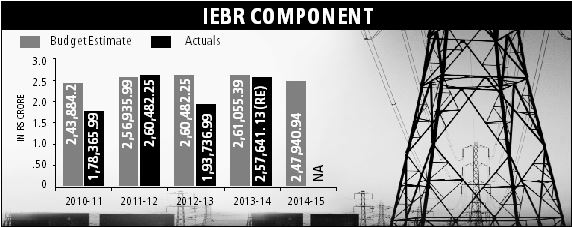The government has asked public sector units to significantly ramp up their internal spending for projects in the new fiscal, as part of a renewed focus on boosting expenditure in infrastructure sectors such as power and highways.
This is expected to be reflected through an incremental Rs 30,000 crore to Rs 50,000 crore in the IEBR projections — or the estimates for mobilisation of funds by way of internal and extra budgetary resources — in the Union Budget 2015-16 as against the Rs 2.47 lakh crore Budgeted estimate for the current fiscal.

The attempt to jumpstart the investment cycle by getting Central PSUs to unlock their cash reserves — as on end-March 2014, the 54 listed CPSUs were estimated to be sitting on cash and surpluses of Rs 1.98 lakh crore — for scaling up capital expenditure is been seen as a means of neutralising the impact of lower private investments, especially at a time when there is pressure on the government to maintain fiscal prudence and thereby limit upfront funding through the Budget.
[related-post]
Story continues below this ad
While the Centre has targeted close to Rs 2.6 lakh crore as IEBR or capital spends by PSUs since 2011-12, the actual spending has been significantly lower in each of these years.
Sources said the finance ministry is now keen to ensure that PSUs actually follow through with their financial commitments in the new fiscal.
 In the run-up to the upcoming Budget on February 28, public sector undertakings have been specifically briefed by the finance ministry at a meeting late last month on the need for stepping up their IEBR — or the estimates for mobilisation of funds by way of internal and extra budgetary resources — projections.
In the run-up to the upcoming Budget on February 28, public sector undertakings have been specifically briefed by the finance ministry at a meeting late last month on the need for stepping up their IEBR — or the estimates for mobilisation of funds by way of internal and extra budgetary resources — projections.
A PSU chief said the finance ministry has specifically asked top PSUs, especially those in the energy sector, to up their IEBR projections.
Story continues below this ad
“A slew of projects are likely to be started in the coming year. There are a lot of cash rich PSUs with idle funds that can be invested in their own projects rather than through funding from banks or government support,” pointed out a senior government official, privy to the development.
The move is in line with the government’s plans to push up public spending in infrastructure sectors as a means to boost growth.
But its leg room to do so is severely restricted due to its commitments to fiscal consolidation that target a 4.1 per cent fiscal deficit in 2014-15 and a further reduction to 3.6 per cent in 2015-16.
In previous years, the Centre has also been prodding PSUs for higher dividends to meet its fiscal deficit targets.
Story continues below this ad
For instance in 2013-14, Coal India Ltd paid a dividend of Rs 18,317 crore to help make up for the shortfall in disinvestment proceeds.
The CPSU-led spending push comes at a time when evidence of any uptick in the broader economy is still relatively nascent. Non-food credit growth, currently stagnant at less than 10 per cent, needs to make a rebound to at least 15-20 per cent.
Even more crucial is infrastructure credit growth, which has dipped sharply from well over 35 per cent growth in 2010-12 to less than 15 per cent in 2013-14.
































